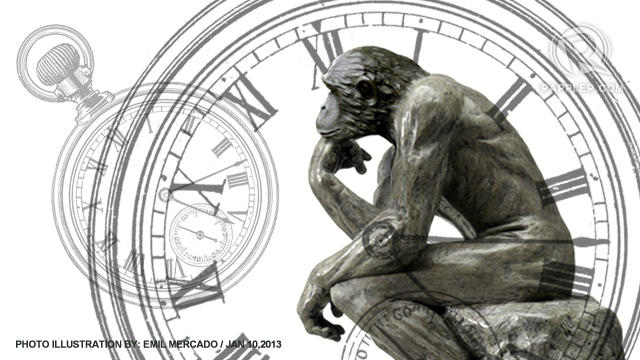SUMMARY
This is AI generated summarization, which may have errors. For context, always refer to the full article.
 Given all the restlessness, dissatisfaction and sometimes even depression that come with midlife crisis, do you think it helps to know that others also have midlife crisis? To be more specific, do you think it would comfort you to know that chimpanzees and orang-utans seem to also share the same “curse?”
Given all the restlessness, dissatisfaction and sometimes even depression that come with midlife crisis, do you think it helps to know that others also have midlife crisis? To be more specific, do you think it would comfort you to know that chimpanzees and orang-utans seem to also share the same “curse?”
Midlife is that twilight around the time you reach your 40s and could last even as you hit your mid 50s. It is graphically depicted by what scientists call a “U-shaped relationship” between wellbeing and age.
A study across 50 nations has found that this phenomenon pervades human lives. This means that it does not matter whether you belong to a rich or poor nation. If you are human, you would most likely be stung by it. Reasons given as to why it occurs differ widely so might science find another reason, specifically in our biology, to explain it?
Enter scientists Alexander Weiss, James E. King, Miho Inoue-Murayama, Tetsuro Matsuzawa, and Andrew J. Oswald who published last October 2012 a study entitled “Evidence for a midlife crisis in great apes consistent with the U-shape in human well-being” in the Proceedings of the National Academy of Sciences in the US.
They studied chimpanzees and orang-utans from many parts of the world. Obviously, these other apes could not sit on couches or fill out questionnaires. So the scientists asked zookeepers and caretakers to fill out established questionnaires that would be the equivalent for detecting midlife crisis for apes. Indeed, they found that in the midlife of chimps and orangs which started at a minimum of 31.2 years, crisis sets in.
The scientists who did the study think that if midlife crisis occurs in our closest biological relatives (chimps are the closest to us sharing over 98% of our genes), then it would be very useful to look into the biological commons we share with these apes and learn about causes and possibly, treatment or relief.

Like apes
Many years ago, I found a book that has been remaindered called “How to Tell your Friends from Apes.” I always joke that as I grow older and sharpen my observation skills of humans, including myself, I can probably write an update of that book. We are so alike other apes in more ways than most of us want to admit.
But it is good that there is a bunch of humans who do not have that kind of intellectual insecurity. We have primatologists and other scientists who look to other apes who have done a great deal in enlightening us humans on how much biology we share with these apes. They showed us that other apes can help us understand ourselves better aside from the pleasure of understanding the other apes themselves.
So what do we have left going for us if we have not seen any of the other apes making any breakthroughs or doing book launches on solutions to this seemingly inescapable crisis? Well, you have the largest brain among all the primates, relative to your body size. Oh and it is not just mere size, but which part of the brain is bigger in us humans. It is the cortex, usually called the “higher brain” because this is where all the thinking, planning, imagination, self-reflection, idea of “others,” belong.
And what luck endowed us with larger brains? So far studies suggest that it was shunning raw food, tool-use and socialization.
It is almost difficult to imagine in human history but yes, there was a time when there were no food shows or master chef showdowns. As far as human nourishment was concerned, al fresco was the only way to go. But some risky-minded exciting human, and I would like to venture, female (I have no scientific evidence for this but given the attentions span of the male kind, want to make a bet?), thought, “fire, heat, meat, yum!”
That freed her energy from chewing raw stuff (which took so much time) to develop her brain for other activities. I also have no scientific evidence for this but I also think this is also why females mature so much faster than males. We knew what to do with fire ahead of males. (Remember what Adam said when asked the original why; he said “she made me do it.” Sheesh.)
Socialization
Tool-use is also a good candidate for brain development. You just have to look now how our brains are changing, for better or worse, with the tools that we come up with. But socialization is I think the most interesting. It is like saying that the most ancient idea of “Facebook” is what made us human.
The main proponent of this idea is Robin Dunbar of Oxford University who looked at the number of individuals in primate groups and connected these to the size of their brains. We are the primates with the most number of individuals that we can manage to consistently “hold” not just in our head but in our lives. This number is not 5000, like the friends you have on FB but only 150.
So I am guessing it is this 150 people in your life whom you can count on to rouse you from your midlife dip. Some of them are probably in it too, some are way ahead of you that you know it is possible to survive and even gain from this ebb of an experience. And if you think it would help to know how to tell your friends from apes, send me a note. – Rappler.com
Maria Isabel Garcia is a science writer. She has written two books, “Science Solitaire” and “Twenty One Grams of Spirit and Seven Ounces of Desire.” Her column appears every Friday and you can reach her at sciencesolitaire@gmail.com.
Add a comment
How does this make you feel?
There are no comments yet. Add your comment to start the conversation.